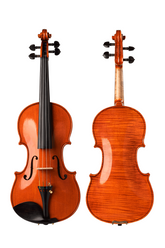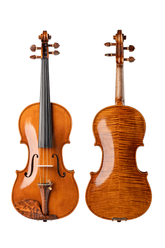Why the Violin Sounds So Haunting on Halloween: The Science Behind the Shivers
When October rolls around and jack-o'-lanterns start appearing on porches across America, there's one instrument that captures the spine-tingling spirit of Halloween better than any other: the violin.
From horror movie soundtracks to ghostly legends, the violin has become synonymous with suspense, mystery, and that delicious sense of unease that makes Halloween so thrilling. But what makes this elegant instrument sound so haunting?

What Makes the Violin Sound So Eerie?
The Human Voice Connection
The violin is often called the instrument closest to the human voice. This isn't just poetic language—it's acoustically true. The violin's frequency range (196 Hz to over 3,000 Hz) overlaps significantly with human speech and singing, which is why violin melodies can feel deeply emotional and even unsettling.
When a skilled violinist plays softly, the sound becomes fragile and distant—like a voice calling from another room. When played aggressively, those same strings produce piercing tones that trigger our primal fear responses. It's this versatility that makes the violin perfect for creating atmosphere in everything from Halloween parties to blockbuster horror films.
The Science of Scary Sounds
Composers and film scorers have long understood that certain violin techniques tap directly into our nervous systems:
High-pitched tremolo: Rapid bow movements create a shaking, anxious sound that mimics human trembling or crying. Think of the iconic shower scene in Alfred Hitchcock's Psycho—those shrieking violin strings have terrified audiences since 1960.
Dissonant intervals: When violins play notes that clash harmonically, our brains register it as "wrong," creating immediate tension and discomfort.
Sul ponticello: Bowing close to the bridge produces a thin, glassy tone that sounds otherworldly—perfect for ghost scenes.
These aren't accidents. Horror composers deliberately use these techniques because they work on a neurological level, triggering the same fear responses as screams or alarm calls.
The Devil's Violinist: Paganini and Supernatural Legends
No discussion of haunted violins would be complete without Niccolò Paganini, the 19th-century Italian virtuoso whose incredible skill sparked rumors that still circulate today.
The Legend of Paganini's Pact
Paganini's performances were so technically advanced—playing impossibly fast passages, using techniques no one had seen before—that audiences genuinely believed he'd sold his soul to the devil in exchange for supernatural talent. Some concert-goers claimed they saw the devil himself standing beside Paganini on stage, guiding his bow.
While the truth is that Paganini simply practiced obsessively and had unusually flexible joints (possibly Ehlers-Danlos syndrome), the legend stuck. Even today, his Caprice No. 24 is considered one of the most devilishly difficult pieces in the violin repertoire.
Haunted Violins in American Folklore
The idea of cursed or haunted instruments has deep roots in American culture too. Folk tales from Appalachia tell of fiddlers who played at crossroads at midnight, hoping to gain extraordinary skill from dark forces. These stories inspired everything from Stephen Vincent Benét's "The Devil and Daniel Webster" to modern horror films.
Halloween Violin Music in Pop Culture
American audiences have been conditioned to associate violins with suspense and horror through decades of film and television.
Iconic Violin Moments in Horror
The Shining (1980): Krzysztof Penderecki's atonal string compositions helped create one of the most unsettling atmospheres in cinema history.
Jaws (1975): While primarily cellos, John Williams' famous theme showed how bowed strings could represent lurking danger.
Coraline (2009): The eerie waltz music features prominently, giving the stop-motion film its haunting, fairy-tale quality.
Insidious (2010): The franchise's use of screeching violins during jump scares has become a modern horror staple.
Techniques That Create Chills
Professional composers use specific violin techniques to maximize the spooky factor:
- Glissando: Sliding smoothly between pitches creates a wailing, ghost-like effect
- Pizzicato: Plucking strings instead of bowing produces sharp, startling sounds like footsteps or dripping water
- Col legno: Striking strings with the wooden part of the bow creates percussive, skeleton-like rattling
- Artificial harmonics: Create thin, ethereal tones that sound supernatural
Best Halloween Violin Songs to Play or Listen To
Whether you're a violinist looking for spooky repertoire or just building the perfect Halloween playlist, these pieces deliver maximum atmosphere.
Easy Halloween Violin Songs for Beginners
- "Hedwig's Theme" from Harry Potter (John Williams)
- "The Addams Family Theme" (Vic Mizzy)
- "Thriller" arranged for violin (Michael Jackson)
- "Ghostbusters Theme" violin cover (Ray Parker Jr.)
- "In the Hall of the Mountain King" (Edvard Grieg) - starts easy, builds intensity
Intermediate Spooky Violin Music
- "Danse Macabre" by Camille Saint-Saëns - The ultimate Halloween violin piece, depicting skeletons dancing at midnight
- "Toccata and Fugue in D minor" (Bach, arr. for violin) - Gothic and dramatic
- "Night on Bald Mountain" (Mussorgsky) - Dark and powerful
- "Theme from Halloween" (John Carpenter) - Minimalist terror
- "Edward Scissorhands Main Theme" (Danny Elfman) - Beautifully melancholic
Advanced Halloween Violin Repertoire
- Paganini's Caprice No. 24 - The devil's favorite piece
- "The Devil's Trill Sonata" (Tartini) - Supposedly composed after Tartini dreamed the devil played it for him
- "Dies Irae" Variations - The medieval death chant transformed
- Ysaÿe's Sonata No. 2 - Includes a haunting Dies Irae movement
- Penderecki's "Threnody for the Victims of Hiroshima" - Avant-garde horror for advanced players
Creating the Perfect Halloween Violin Atmosphere
Performance Tips for Spooky Effect
Want to maximize the haunting quality of your Halloween violin performance? Try these techniques:
- Play in dim lighting: Candlelight (safely distanced!) creates shadows that enhance the mysterious mood
- Use vibrato sparingly: A straight tone sounds more ghostly than a warm, vibrant one
- Experiment with dynamics: Sudden loud notes after quiet passages create effective jump scares
- Add theatrical elements: Costume, staging, and even fog machines can enhance a Halloween recital
Decorating Your Violin for Halloween
While you should never do anything that might damage your instrument, there are safe ways to add Halloween spirit:
- Attach removable charm to your case zipper (bats, spiders, pumpkins)
- Use festive colored rosin (temporary and harmless)
- Switch to orange or black strings if you're feeling bold (D'Addario makes colored strings)
- Add a Halloween-themed shoulder rest cover
- Create a spooky backdrop for online performances
Are Real Violins Actually Haunted?
While there's no scientific evidence of haunted violins, several famous instruments have mysterious reputations:
The Stradivarius Mystique
Antonio Stradivari's violins, made in Cremona, Italy between 1666 and 1737, are considered the finest ever crafted. Some collectors and musicians have reported unusual experiences with these instruments—strange resonances, sounds in empty rooms, or feelings of "presence."
Skeptics attribute these experiences to the instruments' incredible acoustic properties and the psychological weight of owning something so valuable and historic. Believers think centuries of passionate music-making might leave an energetic imprint.
Modern "Cursed" Instruments
Occasionally, estate sales or antique shops produce violins with allegedly dark histories. While these stories make for great Halloween tales, they're usually more about creating mystique and collectible value than genuine supernatural phenomena.
That said, violins are made from wood that was once living trees, and there's something poetic about the idea that they retain a kind of memory or spirit. It's part of what makes them feel so alive when played.
Starting Your Halloween Violin Journey
If this article has inspired you to explore the darker, more dramatic side of violin music, Halloween is the perfect time to start.
Choosing Your First Violin
For beginners interested in playing haunting Halloween melodies, look for a violin outfit that includes:
- A solid wood instrument (laminate violins lack tonal depth)
- Quality strings (dull strings can't produce the bright, piercing tones needed for spooky music)
- A good bow (cheap bows make it harder to control dynamics and articulation)
- A properly fitted shoulder rest (comfort matters for practice sessions)
The 🎻✨ Fiddlover Q033 violin outfit offers exactly these features at a beginner-friendly price point. Its warm, resonant tone makes even simple melodies sound emotional and engaging—perfect whether you're practicing "Hedwig's Theme" or working up to "Danse Macabre."
Made with upgraded craftsmanship and quality materials, the Q033 provides the tonal range needed to explore everything from delicate ghost-like whispers to powerful, dramatic passages. It's an excellent choice for students who want an instrument that will grow with them as they develop their skills.
Why Violins and Halloween Belong Together
At its core, the violin's connection to Halloween isn't really about darkness or fear—it's about emotion and storytelling.
The violin can be beautiful and unsettling, delicate and powerful, comforting and eerie—sometimes all within the same piece of music. It speaks to our love of mystery, our fascination with the supernatural, and our need to feel something deeply.
This Halloween, when you hear violin music drifting through the crisp autumn air—whether it's from a horror movie soundtrack, a costume party playlist, or a student practicing in a nearby house—take a moment to appreciate this remarkable instrument.
For centuries, the violin has bridged the gap between the living and the imagined, the beautiful and the haunting, the earthly and the supernatural. And that's exactly what makes it perfect for the spookiest night of the year.
Ready to create your own haunting melodies? Visit Fiddlover Violin Shop to explore beginner-friendly violin outfits, accessories, and everything you need to start your musical journey this Halloween season.
Frequently Asked Questions
What is the scariest violin piece? "Danse Macabre" by Saint-Saëns is often considered the scariest classical violin piece, depicting dancing skeletons. For modern horror, Penderecki's atonal compositions are genuinely unsettling.
Why do horror movies use violins? Violins can produce sounds that mimic human screams and sobs, triggering primal fear responses. Their wide range and expressive capabilities make them perfect for building tension and suspense.
Did Paganini really make a deal with the devil? No, this was a rumor that spread because Paganini's skills seemed impossible for his era. He likely had a genetic condition (Ehlers-Danlos or Marfan syndrome) that gave him unusual finger flexibility, plus decades of dedicated practice.
What Halloween songs can beginner violinists play? Beginners can start with "The Addams Family Theme," simple arrangements of "Hedwig's Theme," or "In the Hall of the Mountain King" (the beginning sections are accessible).
How do you make a violin sound spooky? Use techniques like sul ponticello (bowing near the bridge), tremolo (rapid bowing), glissando (sliding between notes), and playing dissonant intervals. High registers and minor keys also increase spookiness.





